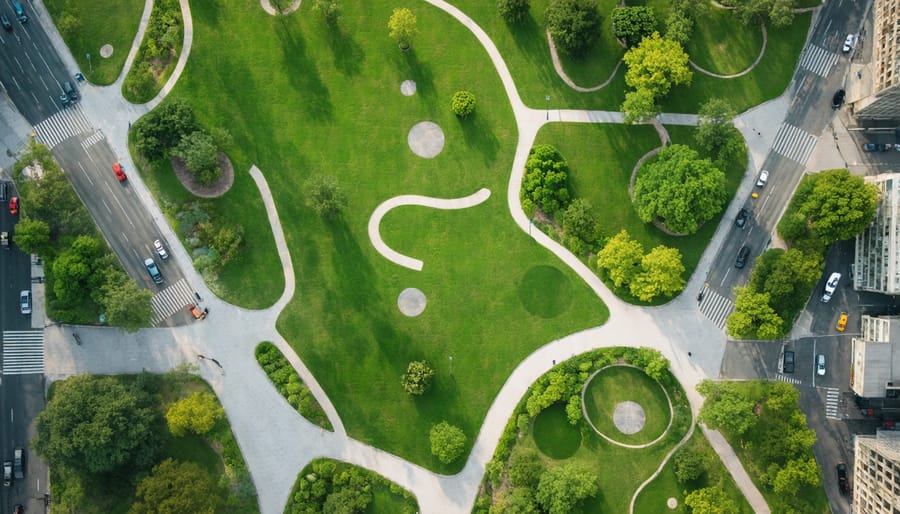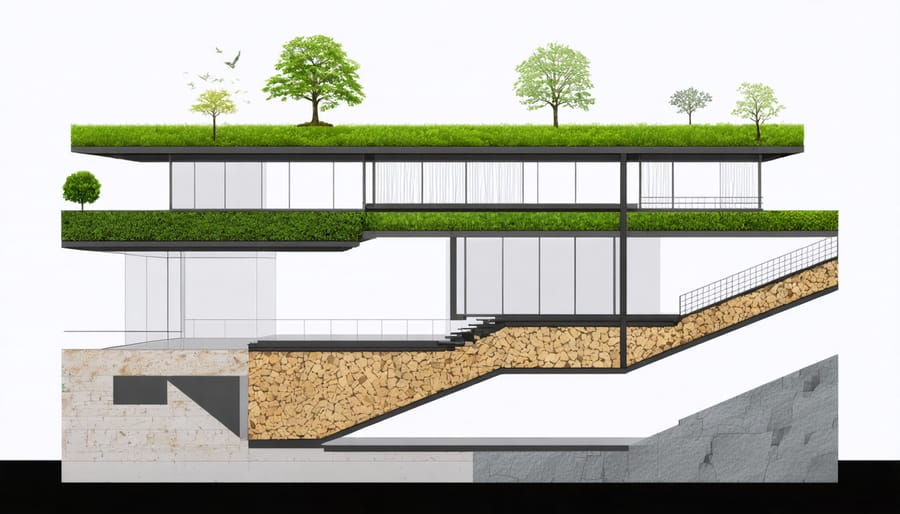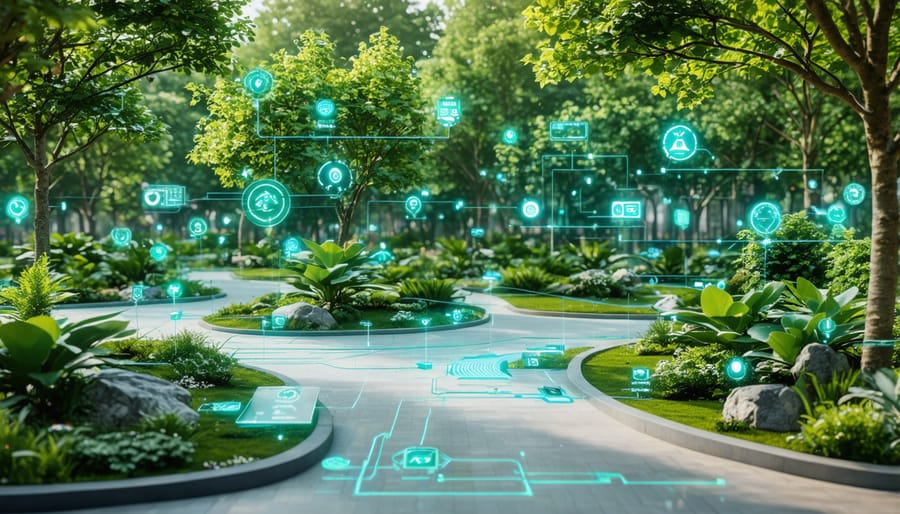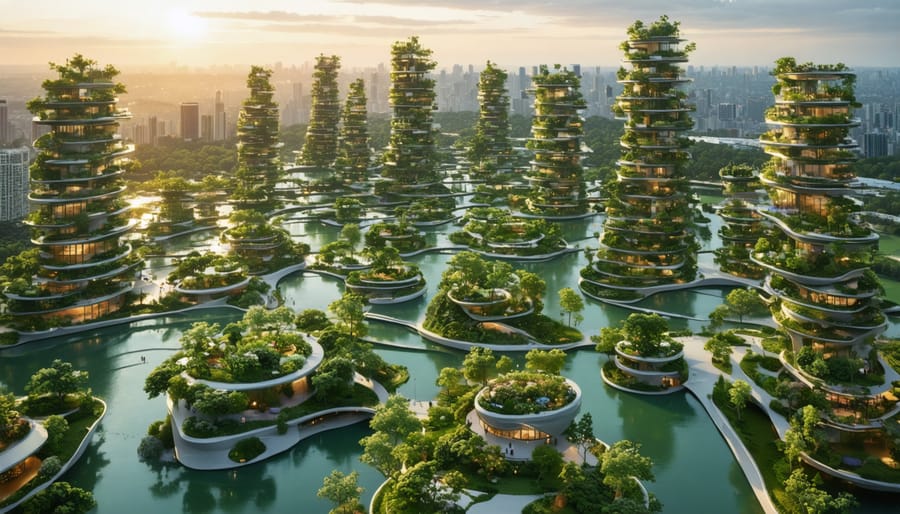Green spaces represent the cornerstone of modern urban green infrastructure, transforming concrete landscapes into vibrant, sustainable ecosystems. These meticulously planned natural areas—ranging from sprawling urban parks to compact rooftop gardens—serve as critical components in contemporary city design, delivering measurable improvements in air quality, temperature regulation, and stormwater management.
As metropolitan regions globally face unprecedented environmental challenges, green spaces emerge as sophisticated solutions that merge ecological functionality with human-centric design. Beyond their aesthetic appeal, these engineered natural environments function as complex systems that enhance biodiversity, reduce urban heat island effects, and provide essential ecosystem services valued at billions annually in major cities.
For construction professionals and urban planners, understanding the technical specifications and implementation requirements of green spaces has become non-negotiable. These spaces represent more than amenities—they are fundamental infrastructure assets that require precise engineering, careful material selection, and strategic integration with existing urban systems to maximize their performance and return on investment.
Defining Urban Green Spaces: More Than Just Parks

Traditional Green Space Categories
Traditional green spaces form the backbone of urban environmental infrastructure, serving multiple functions within the built environment. Parks represent the most recognizable category, ranging from pocket parks of less than an acre to expansive metropolitan parks spanning hundreds of hectares. These spaces typically incorporate both hardscaped and natural elements, providing essential recreational facilities while supporting urban biodiversity.
Urban gardens constitute another vital category, encompassing community gardens, botanical gardens, and institutional green spaces. These areas serve dual purposes of aesthetic enhancement and ecological function, often featuring carefully curated plant collections and specialized landscape designs that demonstrate sustainable horticultural practices.
Urban forests represent the most extensive form of green space, comprising both naturally occurring and planted tree stands within city boundaries. These areas provide crucial ecosystem services, including air purification, temperature regulation, and stormwater management. Professional arborists and urban foresters manage these spaces to maintain canopy coverage and ensure long-term forest health.
Recreational areas, including sports fields, playgrounds, and multi-use spaces, form the fourth major category. These spaces require specialized design considerations to balance intensive use with environmental benefits. Modern recreational areas increasingly incorporate sustainable design elements such as permeable surfaces, native plantings, and integrated stormwater management systems to maximize their environmental contribution while serving their primary recreational function.
Innovative Green Space Solutions
Modern cities are increasingly adopting innovative solutions to integrate green spaces within limited urban environments. These adaptable approaches complement traditional urban sustainability practices while maximizing spatial efficiency.
Green roofs represent a significant advancement in building-integrated vegetation, offering multiple benefits including thermal regulation, stormwater management, and biodiversity enhancement. Contemporary systems incorporate sophisticated drainage layers, root barriers, and specialized growing media to ensure optimal performance and structural integrity.
Vertical gardens, also known as living walls, transform building facades into dynamic green installations. These systems utilize hydroponics or soil-based modules, complete with automated irrigation and monitoring systems. They’re particularly effective in dense urban cores where horizontal space is limited.
Bioswales present an engineered approach to green infrastructure, combining vegetation with sophisticated drainage design. These landscape elements manage stormwater runoff while providing aesthetic value and supporting urban biodiversity. Their strategic implementation along streets and parking areas helps filter pollutants and reduce urban heat island effects.
Pocket parks optimize underutilized urban spaces, transforming them into valuable community assets. These compact green spaces incorporate carefully selected vegetation, permeable surfaces, and multi-functional design elements to maximize their impact. Despite their small footprint, they significantly contribute to urban air quality and community well-being.
Technical Specifications and Design Considerations
Infrastructure Requirements
The successful implementation of urban green spaces requires robust infrastructure planning that addresses three critical components: drainage, soil engineering, and structural support. At the foundation, sustainable drainage systems must be designed to manage both excessive rainfall and maintain adequate water levels during dry periods. These systems typically incorporate permeable surfaces, bioswales, and underground water storage facilities to prevent waterlogging while ensuring optimal plant hydration.
Soil specifications for urban green spaces demand careful consideration of load-bearing capacity, nutrient content, and drainage characteristics. Engineers must specify appropriate soil compositions that balance organic matter content (typically 5-15%) with mineral components while maintaining structural stability. The soil profile should achieve a minimum depth of 1.0-1.5 meters for trees and 0.3-0.5 meters for smaller vegetation, with proper compaction rates to support root development without compromising drainage.
Load-bearing considerations are particularly crucial for rooftop gardens and elevated green spaces. Structural engineers must calculate dead loads (permanent weight of soil, plants, and infrastructure) and live loads (temporary weights from maintenance activities, snow, and rain accumulation). Modern green roof systems typically require supporting structures capable of handling loads between 100-150 kg/m² for extensive systems and up to 500 kg/m² for intensive designs. Additionally, waterproofing membranes, root barriers, and adequate slope gradients (minimum 2%) must be incorporated to protect underlying building structures and ensure proper drainage flow.

Maintenance and Sustainability Features
Effective maintenance and sustainability features are crucial for the long-term success of urban green spaces. Modern irrigation systems employ smart technology with soil moisture sensors and weather-based controllers, reducing water consumption by up to 30% compared to traditional methods. These systems can be integrated with rainwater harvesting infrastructure, utilizing collected stormwater for irrigation during dry periods.
Material selection plays a vital role in sustainability. Permeable pavements and recycled materials are increasingly used in pathways and recreational areas. Native plant species, selected for their adaptability to local climate conditions, require minimal maintenance and support local biodiversity. Green infrastructure elements like bioswales and rain gardens are constructed using sustainable materials that facilitate natural water filtration and reduce maintenance needs.
Long-term maintenance planning involves comprehensive strategies that address seasonal variations and climate change impacts. Annual maintenance schedules typically include regular soil testing, pruning cycles, and periodic assessment of irrigation system efficiency. Preventive maintenance protocols help identify potential issues before they become costly problems, while adaptive management approaches allow for adjustments based on performance monitoring data.
Many cities now implement digital maintenance management systems that track maintenance activities, monitor resource usage, and schedule preventive care. These systems often integrate with GIS mapping to optimize maintenance routes and resource allocation. Professional maintenance teams require specialized training in sustainable landscaping practices, including organic pest management and water-efficient maintenance techniques, ensuring the longevity and ecological integrity of urban green spaces.
Integration with Urban Infrastructure
Connectivity Solutions
Connectivity solutions in urban green spaces play a crucial role in creating resilient city ecosystems. These solutions primarily comprise green corridors and wildlife passages that link various green infrastructure projects across metropolitan areas. By establishing interconnected networks of vegetation, cities can effectively combat the urban heat island effect while supporting biodiversity.
Strategic implementation of green corridors requires careful planning and integration with existing infrastructure. These corridors typically incorporate native vegetation, permeable surfaces, and dedicated wildlife crossings to facilitate animal movement through urban areas. Design considerations must account for both ecological functionality and urban development constraints, ensuring seamless integration with surrounding built environments.
Wildlife passages, including underpasses and overpasses, are engineered structures that enable safe animal movement across urban barriers such as roads and railways. These passages require specific design parameters, including appropriate dimensions, natural substrate materials, and vegetative cover to encourage wildlife utilization.
Urban heat island mitigation strategies incorporate these connectivity elements through strategic placement of vegetation and water features. Green corridors act as natural ventilation channels, facilitating air movement and temperature regulation throughout the urban landscape. When properly designed, these networks can reduce ambient temperatures by 2-8°C in surrounding areas, significantly improving urban microclimate conditions while supporting ecosystem services.
Smart City Integration
Modern green space management increasingly relies on smart city technologies to optimize maintenance, enhance user experience, and maximize environmental benefits. IoT sensors deployed throughout urban green spaces monitor crucial parameters such as soil moisture, air quality, and visitor flow patterns. These systems enable real-time data collection and analysis, allowing facility managers to make informed decisions about irrigation schedules, maintenance requirements, and resource allocation.
Advanced monitoring systems incorporate artificial intelligence to predict maintenance needs and identify potential issues before they become problematic. For example, smart irrigation systems automatically adjust water distribution based on weather forecasts and soil conditions, reducing water waste while maintaining optimal plant health. Environmental sensors track biodiversity indicators, helping managers assess the ecological impact of green spaces and implement evidence-based conservation strategies.
Digital twin technology creates virtual replicas of green spaces, enabling managers to simulate different scenarios and optimize design modifications before implementation. Mobile applications provide users with real-time information about park facilities, events, and environmental conditions while collecting valuable user feedback and usage patterns.
Integration with city-wide systems allows green spaces to contribute to broader urban sustainability goals. Smart lighting systems adjust illumination based on natural light and user presence, while waste management systems optimize collection routes and monitor recycling effectiveness. These technological solutions not only improve operational efficiency but also enhance the overall sustainability and resilience of urban green spaces.

Case Study: Successful Urban Green Space Implementation
The High Line in New York City stands as one of the most influential urban green space transformations of the 21st century. This 1.45-mile-long elevated park, built on an abandoned railway line, demonstrates how innovative thinking can convert industrial infrastructure into vibrant public spaces that benefit both the environment and community.
The project, initiated in 2006, faced significant challenges during implementation. The primary obstacle was the structural integrity of the elevated railway, which required extensive engineering assessment and reinforcement. Environmental concerns included soil contamination from decades of railroad use, necessitating specialized remediation techniques and the development of a custom soil system for sustainable plant growth.
Budget constraints initially threatened the project’s scope, but through public-private partnerships and strategic fundraising efforts, the High Line secured $187 million for the first two phases. The Friends of the High Line organization played a crucial role in gathering community support and maintaining sustainable funding sources.
The design team, led by James Corner Field Operations and Diller Scofidio + Renfro, incorporated innovative solutions such as:
– Biodiversity-focused plantings featuring 500+ species of plants
– Smart irrigation systems utilizing rainwater collection
– Integration of solar-powered lighting
– Permeable pathways for natural drainage
– Microclimate considerations in seating and shade placement
The results have exceeded expectations. The High Line attracts over 8 million visitors annually and has generated more than $1 billion in economic activity. Property values in adjacent neighborhoods have increased significantly, while the park has reduced urban heat island effects by 2-3°C in surrounding areas.
The project’s success has inspired similar initiatives worldwide, demonstrating how thoughtful green space implementation can transform urban infrastructure while addressing environmental challenges. The High Line serves as a blueprint for future urban green space projects, particularly in repurposing existing infrastructure for public benefit.
Urban green spaces have proven to be indispensable elements of modern city planning, offering multifaceted benefits that extend far beyond aesthetic appeal. As our analysis has shown, these spaces serve as critical infrastructure components, providing essential ecosystem services, improving public health outcomes, and contributing to climate resilience in urban environments.
The implementation challenges we’ve examined, including land availability and maintenance costs, can be effectively addressed through innovative design solutions and strategic planning approaches. The success stories from cities worldwide demonstrate that with proper investment and commitment, green spaces can be successfully integrated into even the most densely developed urban areas.
Looking ahead, the future of urban green spaces appears increasingly vital. Climate change adaptation requirements and growing urbanization will drive greater demand for these spaces. We can expect to see more vertical gardens, biodiverse roof systems, and integrated green infrastructure solutions becoming standard features in urban development projects.
For construction professionals and urban planners, staying ahead of these trends means embracing new technologies and sustainable design practices. The integration of smart systems for maintenance, water management, and biodiversity monitoring will become increasingly common. Investment in urban green spaces will continue to yield significant returns, both in terms of environmental benefits and property values.
As we move forward, the success of urban green spaces will depend on collaborative efforts between construction professionals, city planners, and policymakers, ensuring these vital urban assets continue to evolve and serve future generations.

